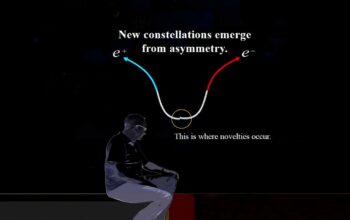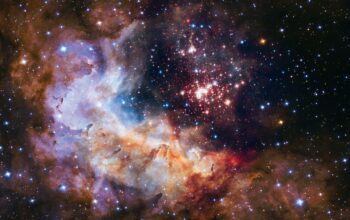The universe is a grand stage of interaction, where celestial bodies engage in intricate dances that shape the cosmos over eons. Among these celestial entities, binary star systems represent a particularly fascinating phenomenon. These systems consist of two stars bound by gravitational forces, orbiting a shared center of mass. Binary systems are not mere astronomical curiosities; they offer profound insights into cosmic evolution, elemental synthesis, and the complexities of matter recycling in the universe. Through the lens of binary systems, we encounter the tantalizing concept of “stardust”—the very building blocks of life and matter on Earth. The mere existence of such relationships among stars prompts an exploration that promises a transformative perspective on stellar dynamics and the origins of the elements that constitute our own existence.
One might ponder how binary star systems contribute to the cosmic alchemy that seeds the universe with essential elements. When stars evolve, they engage in a multi-phase life cycle comprising nuclear fusion, mass loss, and possibly even supernova explosions. In a binary configuration, these processes are amplified, leading to a more nuanced interaction. As one star exhausts its nuclear fuel, it may expand into a red giant, spilling its outer layers into the surrounding interstellar medium. This mass transfer can pave the way for fascinating astrophysical phenomena, including accretion disks and shared stellar atmospheres, which foster a richer chemical environment for the nucleosynthesis of heavier elements.
Consider the particular mechanics involved in mass transfer processes: When a massive star in a binary system exhausts its hydrogen fuel, it bloats and may begin to siphon mass from its companion. This transfer may occur smoothly, resulting in an enrichment of heavier elements in both stars. Alternatively, the process can escalate into chaotic regimes, including nova eruptions, where thermonuclear reactions lead to explosive mass ejection. The material jettisoned during such outbursts contributes to the cosmic dust that eventually aggregates into new stars and planets. Thus, binary systems serve as multicellular reactors, sustaining a thriving ecosystem of matter recycling.
Furthermore, the interactions of binary star systems highlight the role of gravitational forces as manipulators of elemental distribution in space. The gravitational pull between two stars not only determines their orbital harmonics but also influences the fate of surrounding material. As stars evolve, their mass loss can create intricate nebulae—clouds enriched with the remnants of stellar life. These nebulae serve as fertile grounds for star formation. It is within these stellar nurseries that elements forged within the hearts of stars find new homes. The cyclical nature of stellar life emphasizes that stellar evolution is not just a solitary affair; it is a collaborative process, encapsulated in the term “cosmic companions.”
Moreover, the study of binary systems opens a window into the variability of stellar evolution paths. Different mass ratios between the components of a binary system can lead to divergent evolutionary outcomes. In a system where one star is significantly more massive than its companion, the dominant star’s lifecycle will dictate the fate of both. Such configurations can result in phenomena such as black hole formation, where the gravitational pull of the remnant star collapses into a singularity, leaving behind a vast void while potentially capturing or influencing its companion in the process. The dynamics of these binaries prompt questions regarding the distribution of black holes across the universe and their potential roles in galaxy formation and evolution.
A shift in perspective becomes particularly pertinent when considering the cosmic implications of binaries on the astrophysical landscape. Disparate elements born from supernovae and other cataclysmic events constitute the “stardust” that seeds new planetary systems, and ultimately, life itself. The earth, rich in carbon, oxygen, and nitrogen, owes its atomic constituents to the recycled products of binary systems. Thus, one can assert that the very atoms that compose our bodies and the fabric of our terrestrial environment have, conversely, traversed the lens of stellar evolution through such cosmic partnerships.
Furthermore, the study of binary systems represents one of the frontiers of modern astronomy. As detection methods advance—such as the use of gravitational wave observatories and precision astrometry—our appreciation of these cosmic phenomena deepens. Observing the interplay of binary stars has implications that extend beyond mere observation; it touches upon the very fabric of fundamental physics. As stars merge or evolve in ways that transcend conventional predictions, they pose intriguing questions about the limits of our understanding of gravitational interactions and mass dynamics in extreme conditions.
Ultimately, the intricate relationships within binary star systems compel a re-evaluation of our cosmic narrative. Rather than perceiving the universe as a collection of isolated entities, the existence of binaries beckons a holistic framework where collaboration and intertwining destinies dominate heavenly spheres. The concept of “cosmic companions” reveals that the universe is an interconnected web of matter and energy—each star, each particle, has a history and a heritage that is bound to others. It challenges us to consider ourselves not just as observers but as integral pieces of a much larger cosmic puzzle. Understanding binary systems invites a broader curiosity, leading us to question our place in a cosmos that continuously evolves, recycles, and transforms.
As the interplay of celestial bodies unfolds, it becomes evident that binary systems do more than coalesce; they foster a continuous exchange of matter across the universe, thereby contributing to the stardust that nurtures new worlds. In this cosmic orchestration, every element has a story that intertwines with the stories of countless others, evoking a sense of kinship among all matter. As we peer into the cosmic ocean of stars, we glimpse a shared heritage that unites all of existence—a narrative filled with mystery, continuity, and profound promise.












